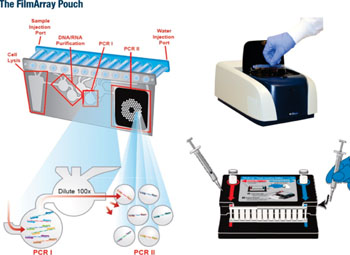Cerebrospinal Fluid Nucleic Acid-Based Test Detects Multiple Pathogens
By LabMedica International staff writers
Posted on 27 Oct 2015
Meningitis and encephalitis are inflammatory diseases of the membranes that surround the brain and spinal cord and can be caused by bacterial, viral or yeast infections and such infections can cause brain damage and can be fatal if not treated rapidly. Posted on 27 Oct 2015
The first cerebrospinal fluid (CSF) nucleic acid-based test for simultaneous detection of multiple pathogens that can cause central nervous system infections can now be marketed. The test uses CSF specimens from patients who have signs and/or symptoms of meningitis or encephalitis and it is intended as an aid in the diagnosis of those diseases when used in conjunction with other clinical and laboratory findings.

Image: The FilmArray Multiplex Polymerase Chain Reaction System available for diagnosing pathogens causing meningitis and encephalitis (Photo courtesy of BioFire Diagnostics).
The US Food and Drug Administration (FDA; Silver Springs, MD, USA) reviewed data for the test through the de novo classification process, a regulatory pathway for some low- to moderate-risk devices that are novel and not substantially equivalent to any legally marketed device. The clinical performance of the test was evaluated by a prospective study of CSF samples taken from 1,560 patients with suspected meningitis/encephalitis where results for the ME Panel were compared to results from other test methods, including culture.
Another study included 150 clinical CSF samples that were previously determined to contain microorganisms, while a third study included 425 CSF samples that were artificially prepared with specific concentrations of bacteria or viruses. Study results demonstrated high agreement between the FilmArray ME Panel (BioFire Diagnostics; Salt Lake City, UT, USA) comparator methods and expected results. Bacteria and yeast pathogens identified by the FilmArray ME Panel are Escherichia coli K1, Haemophilus influenzae, Listeria monocytogenes, Neisseria meningitidis, Streptococcus agalactiae, Streptococcus pneumoniae, and Cryptococcus neoformans/gattii. Viruses identified by the FilmArray ME Panel are Cytomegalovirus, Enterovirus, Herpes simplex virus 1, Herpes simplex virus 2, Human herpesvirus 6, Human parechovirus, and Varicella zoster virus (Human herpesvirus 3).
Alberto Gutierrez, PhD, director of the Office of In Vitro Diagnostics and Radiological Health at the FDA's Center for Devices and Radiological Health, said, “Testing one sample for many pathogens and potentially having test results sooner should allow physicians to use this information, along with other clinical findings and test results, to provide improved diagnosis and treatment for these very serious illnesses.”
Related Links:
US Food and Drug Administration
BioFire Diagnostics













